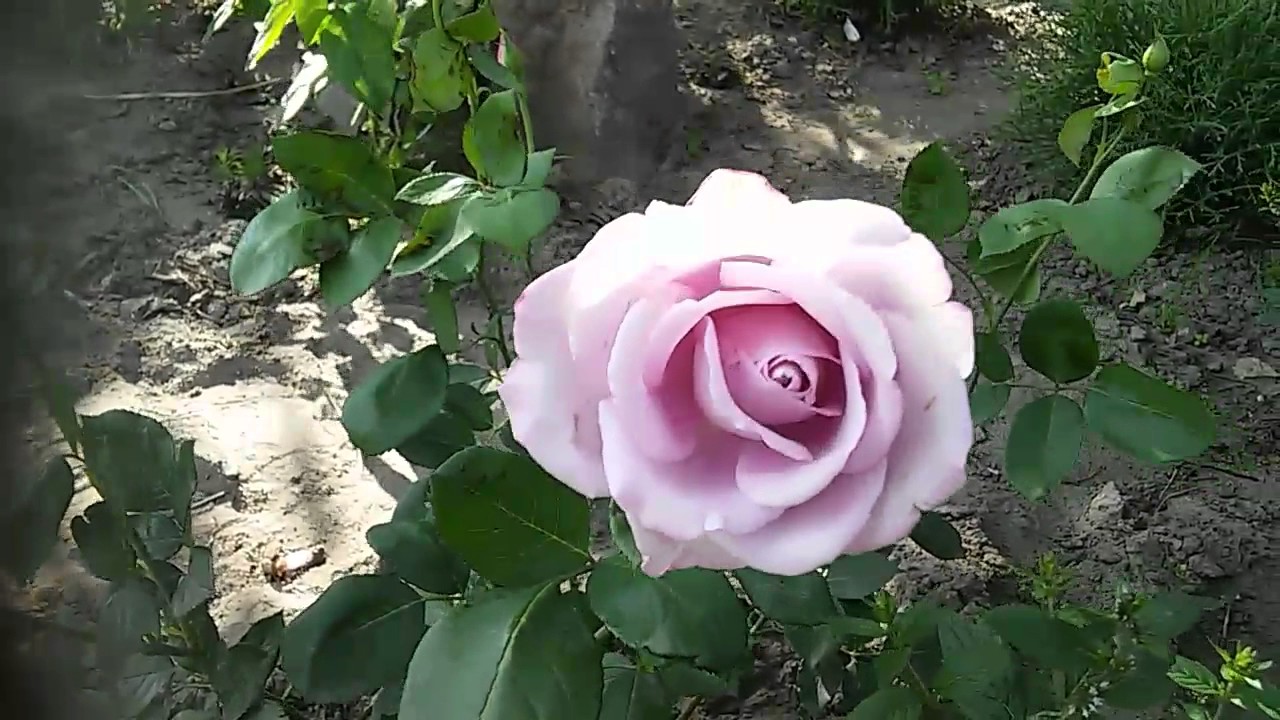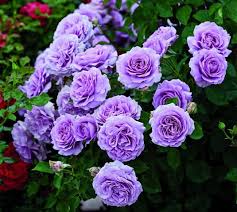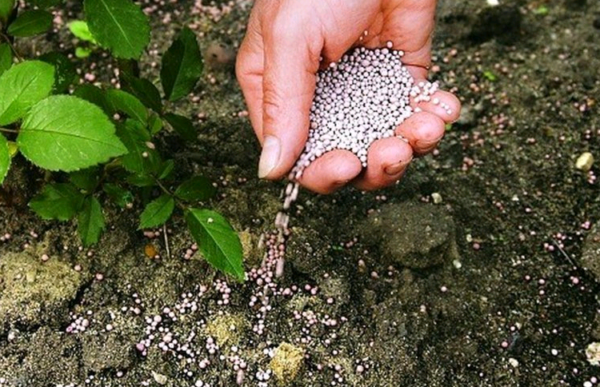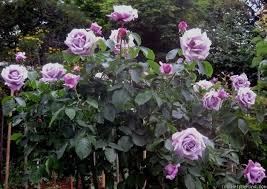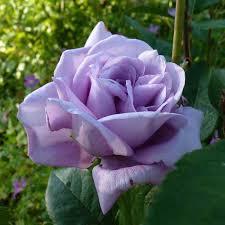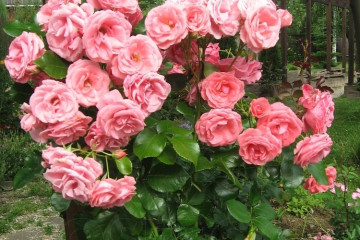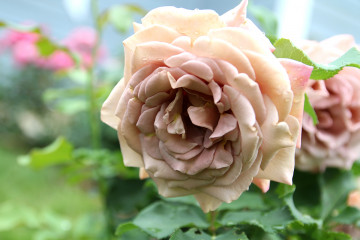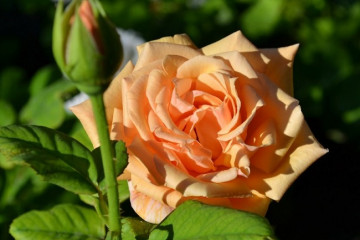Rose Blue Moon (Blue Moon) - description of the flower of the original coloring
Content:
Large beautiful blue moon rosebuds attract attention from afar with their original blue hue. The blue moon rose has gained popularity among flower lovers precisely because of its unusual color.
Breeding history
Rose Blue Moon was bred in 1964 by German breeders. Within a short period of time, this variety has become one of the most popular among flower growers. A decade later, breeders improved the variety, after which its curly version appeared.
Brief description, characteristics of the variety
Climbing rose Blue Moon got its name for the unusual lilac-blue color of the bud and petals. Depending on the place of cultivation, the shade of the flower may vary. For example, if placed in the shade, the shade will be pink. And in a sunny area, the color becomes pronounced blue.
There are two types of this variety:
- climbing. Scourges reach a length of about 4 meters. The color of the buds is silvery-lilac. Inflorescences are large, up to 10 cm in diameter;
- tea-hybrid. The height of the bush can be up to one meter. The circumference of the buds is 12 cm. The color is lavender, blue, lilac.
Climbing and hybrid tea are both re-flowering. The buds have a rich, pleasant aroma. The plant is resistant to powdery mildew, black spot.
Advantages and disadvantages of blue moon rose
The main advantages of the variety include:
- rare color;
- large buds;
- rich aroma;
- long flowering.
After the buds have faded, after a while they bloom again.
The disadvantages of roses include:
- poor resistance to low temperatures;
- insufficient resistance to disease;
- the need to grow in a sunny area;
- the need for careful preparation for wintering.
Use in landscape design
Such flowers often serve as basic ones in landscape design. Bushes on a green grassy lawn look great, go well with conifers: thuja, cypress, blue spruce. Ornamental shrubs can serve as a background for roses.
Growing a flower, how to plant it in open ground
In what form is the landing
Reproduction of the plant occurs by cuttings, dividing the bush and layering. High-quality seedlings should have the following parameters: a branched root system with elastic roots; at least three shoots; dormant kidneys; green root collar.
Most often, flower growers plant a finished seedling obtained by cuttings.
What time is the boarding
The blue moon climbing is recommended to be planted in the first half of May. During this period, the soil warms up well, so the root system will take root much faster. If subzero temperatures persist in the morning, it is better to postpone planting the plant.
Location selection
A hybrid plant variety for full growth and development requires planting in a well-lit area, partial shade may be present.
How to prepare the soil and flower for planting
Before planting, you need to carefully prepare the site. It is important that the root system is freely located in the ground. The soil is dug half a meter deep. The hole should be about a meter wide. In the finished planting hole, add the following mixture in equal parts:
- land;
- sand;
- peat;
- humus or bird droppings;
- superphosphate (1 glass);
- wood ash (1 glass).
Planting procedure step by step
Before planting, the seedling is immersed in water for five hours, so the root system is sufficiently moistened and straightened. Examine the roots, remove damaged and rotten parts, sprinkle the cut points with wood ash. Shorten the shoots - this will allow the root system to strengthen, the bush will grow rapidly.
Dig and prepare the planting hole. Lay small pebbles and sand at the bottom of the pit - this is a drainage layer. Place the seedling in the center of the hole, gently spread the roots. Sprinkle with earth on top, tamp. Sprinkle the root collar by three centimeters. Mulch the soil, water abundantly.
Plant care
Watering rules and humidity
To ensure vigorous growth and abundant flowering of the rose, it is important to intensively and regularly moisten the soil under the bush. You need to water in the evening. For irrigation, warm, settled water is used. How often you need to water will be directly related to temperature conditions and air humidity.
Top dressing and soil quality
After each watering, the soil must be loosened and mulched, thanks to which the roots will not overheat, and moisture will be retained.
Each rose bush needs periodic fertilization. During the entire growing season, you need to feed the rose at least five times. For the first time, mineral and organic compounds are applied in the spring.
Pruning and replanting
The Blue Moon hybrid tea rose is pruned two times:
- the spring procedure is necessary in order to form a bush, to stimulate long and abundant flowering. When buds appear, cut off the shoots by 20 cm, at least 4 buds should remain on each of them, be sure to remove dry, damaged and frozen shoots;
- the autumn procedure is performed when preparing the plant for wintering. Cut each shoot by about a third, remove grassy and too thin shoots.
Features of wintering a flower
This variety is moderately resistant to temperatures below freezing. In late autumn, after pruning, you need to cover the root collar with a substrate of humus and dry soil. When the first frosts begin, cover with spruce branches on top.
Blooming rose
A period of activity and rest
Intense bloom occurs twice during the growing season if the plant is properly cared for. Single buds may appear, or small inflorescences may appear. The flowering period is long from early summer to mid-autumn.
Care during and after flowering
After each flowering, the shoots on which there were buds, cut off 10 centimeters.
What to do if it does not bloom, possible reasons
If the rose does not bloom in the first year after planting, the reason may be the build-up of green mass by the bush. The next year, flowering will be abundant and long lasting.
You can also add top dressing at the beginning of the growing season. For this, mineral and organic fertilizers, superphosphate are used.
Flower propagation
When is it produced
The division of the bush is carried out in the spring, before the formation of buds. Cutting is carried out in the summer, after the beginning of the appearance of buds. Layering is done at any time during the growing season, after the end of flowering.
Detailed description
To divide the bush, they dig it out of the soil, carefully cut it into two parts. Each part is planted in a separate planting pit.
Cuttings. Take a green dense shoot. At least three kidneys must be present on it. Trim, the length of the cutting should be about 12 cm. The lower cut must be treated with a substance to accelerate the emergence of the root. Plant the stalk in the soil, cover with a jar, bottle or film on top. Water regularly.
Diseases, pests and ways to control them
The most common diseases of this variety are:
- downy mildew or downy mildew. The fight against the disease is carried out with the help of Fundazol;
- gray rot. Destroyed by Fundazole or Euparen; rust. Processing is carried out by Fitosporin.
The most common pests are:
- rose aphid. Destroyed with Spark, Alatar;
- penny. Destroyed with any insecticide;
- leaf roll. Treated with Chlorophos;
- sawfly. They are processed with Aktellik; spider mite. Destroyed with the help of Alatar, Aktara.
The flower is known all over the world for its bright blue petals and pleasant aroma. The plant requires certain care conditions. Knowing how to properly plant and care for the Blue Moon rose, you can enjoy the wonderful bloom and scent of flowers throughout the summer.
